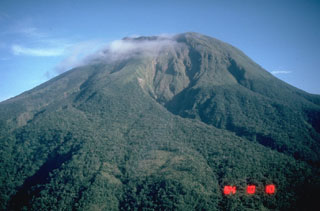Report on Bulusan (Philippines) — 5 January-11 January 2011
Smithsonian Institution / US Geological Survey
Weekly Volcanic Activity Report, 5 January-11 January 2011
Managing Editor: Sally Sennert.
Please cite this report as:
Global Volcanism Program, 2011. Report on Bulusan (Philippines) (Sennert, S, ed.). Weekly Volcanic Activity Report, 5 January-11 January 2011. Smithsonian Institution and US Geological Survey.
Bulusan
Philippines
12.769°N, 124.056°E; summit elev. 1535 m
All times are local (unless otherwise noted)
During 4-10 January, PHIVOLCS reported that 2-8 daily volcanic earthquakes at Bulusan were detected by the seismic network. Clouds usually prevented observations, but on 5 or 6 January steam was seen rising from a known NW thermal vent. The Tokyo VAAC reported that on 6 and 7 January ash was observed according to notices from the Manila airport (RPLL). The Alert Level remained at 1 (on a scale of 0-5).
Geological Summary. Luzon's southernmost volcano, Bulusan, was constructed along the rim of the 11-km-diameter dacitic-to-rhyolitic Irosin caldera, which was formed about 36,000 years ago. It lies at the SE end of the Bicol volcanic arc occupying the peninsula of the same name that forms the elongated SE tip of Luzon. A broad, flat moat is located below the topographically prominent SW rim of Irosin caldera; the NE rim is buried by the andesitic complex. Bulusan is flanked by several other large intracaldera lava domes and cones, including the prominent Mount Jormajan lava dome on the SW flank and Sharp Peak to the NE. The summit is unvegetated and contains a 300-m-wide, 50-m-deep crater. Three small craters are located on the SE flank. Many moderate explosive eruptions have been recorded since the mid-19th century.
Sources: Philippine Institute of Volcanology and Seismology (PHIVOLCS), Tokyo Volcanic Ash Advisory Center (VAAC)

